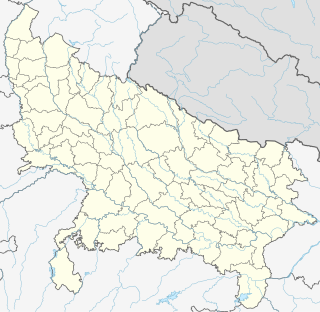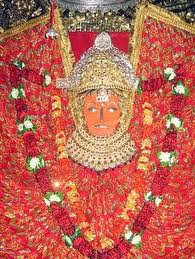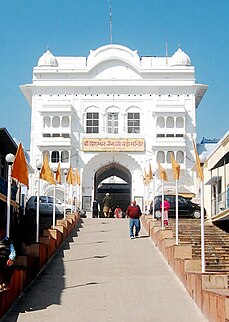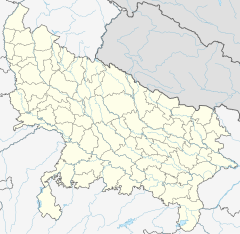
Brahmani or Brahmi, is one of the Sapta Matrika Goddesses called Matrikas. She is a form of Saraswati and is considered as the Shakti of the creator god Brahma in Hinduism.

Pratapgarh, also called Belha or Bela Pratapgarh, is a city and municipality in the state of Uttar Pradesh in India. It is the administrative headquarters of Pratapgarh district, part of the Allahabad division.

Jeenmata is a village in Sikar district of Rajasthan, India. It is located at a distance of 29 km from Sikar town in south. There is an ancient Temple dedicated to Shree Jeen Mataji(Goddess of Power). Millions of devotees assemble here for a colourful festival held twice in a year in the month of Chaitra and Ashvin during the Navratri. There are a number of dharamshalas to accommodate large number of visitors.

Bagra is a village in the Jalore district in the Marwar region in Rajasthan state in India. Bagra lies 18 km south of the town of Jalore on Jalore-Sirohi road.

Chhibramau is a city with the status of "Nagar Palika Parishad" and a Subdivision of Kannauj district in the northern state of Uttar Pradesh, India. The city is lying along the National Highway No. 91 on Delhi (Dadri) – Kanpur route. The nearest airport is at Lucknow (150 km) and Gursahaiganj Railway Station is the nearest railway station.

Shahganj is a city and a municipal board in Jaunpur district in the Indian state of Uttar Pradesh.

Reotipur is a village located in the Ghazipur district of Uttar Pradesh, India. Reotipur is a large village located in zamania tehsil of Ghazipur district,and Kamsar-o-bar region of zamania tehsil. Uttar Pradesh with total 3457 families residing. The Reotipur village has population of 26597(2011 population census) .it is the largest village in Ghazipur district. This village is very old, believed to have been established in 1527AD.

Suhwal is a village in Kamsar region of Ghazipur district under Reotipur block. It is situated on Ghazipur to Buxar Road 8 km from Ghazipur City. It has population of 10814 as per 2011 Census. The Village is quite old. It has its own local administration under Panchayati Raj system, with Gram Pradhan as head of local administration. There are two Government Secondary Schools, 3 Government Primary Schools and few other privately run Schools. There is a small permanent Market in western Side of Village and also a weekly Market. Suhwal is a center of Shopping and Primary Education for many other small villages situated on its fringe.
The Hathras Fort, , is an 18th-century fort. The fort was constructed by Jat king Raja Dayaram Singh, and is located in the town of Hathras in Uttar Pradesh. Commonly known as Kila Gate, Hathras Fort is among the best tourist site. However, it is not registered as a tourist place in Uttar Pradesh.
Hardasipur is a village in Jaunpur district, Uttar Pradesh, India.
Uttar Kumar is an Indian film actor, writer, director, who mainly works in Haryanvi films. Kumar has acted in more than forty films including Dhakar Chhora released in 2004, which broke box office records by earning around 85 million for film worth of around 450,000.

Bhidauni is a village and Gram panchayat of two villages, Kewat Nagla and Bhidauni officially known as Bhidauni Bangar located between the Yamuna river and Yamuna Expressway in the Mat Tehsil of Mathura district, Uttar Pradesh, India. The village is about 45 kilometres from Mathura City on the Raya Road joining to Bajna Road.

Ramrekha Mandir is an ancient Hindu temple of Lord Ram and Goddess Sita.

Shri Digamber Jain Prachin Bada Mandir is a Jain temple complex in located in Hastinapur, Uttar Pradesh. This is the oldest Jain temple in Hastinapur. The temple is dedicated to Shantinatha, the 16th Jain Tirthankara.

Makhauda Dham is one of the most ancient places of Harraiya tehsil in Basti district where Raja Dashrath performed yagya with the help of Sage Rishyasringa on the advice of Vashistha. Name of Yajna was the Putrakameshti. It is said that Dasharatha and Kaushalya has a daughter Shanta, who was Rishyashringa's wife. As the conclusion of the Yagya drew near Agni sprang out from the yagnakunda and handed Dasharatha a pot of kheer advising him to distribute it among his queens. Kaushalya ate half the kheer, Sumitra ate a quarter of it. Kaikeyi ate some and passed the pot back to Sumitra who consumed the kheer a second time.

Kakora is a village in Budaun Tehsil and Budaun district, Uttar Pradesh, India. Its village code is 128608. The village is administrated by Gram Panchayat.

Swami Avdheshanand Giri is an Indian Hindu spiritual leader, author, philosopher and preacher from Bulandshahr. He is the Acharya Mahamandaleshwar of Juna Akhara, the oldest and largest order of sadhus in India. He has initiated about one million Naga Sadhus and he is their first Guru.
Sikri Khurd, also known as Sikri Kalan, is a village at the periphery of Modinagar city of Ghaziabad district in Uttar Pradesh, India. The village is known for its 17th century Sikri Mata Temple and related Devi Fair, which is organised every year for the nine days of Navaratri of Chaitra month, marking the beginning of a new year in Hindu calendar.
Aantri Mata an ancient temple is located in Antri Mata village, about 35 km from Manasa Nagar in Neemuch District of Madhya Pradesh.The wondrous temple of Mata Aantri is built in the waterlogged area of Gandhi Sagar. Mother Goddess Antri Chandravat is the daughter of the Rajputs. On completion of the vow, devotees offer tongues to the goddess mother. Recognition and devotees claim that after offering the tongue, the tongue of the devotees comes automatically. Now, on the completion of the vow, many devotees have started offering silver tongues.








